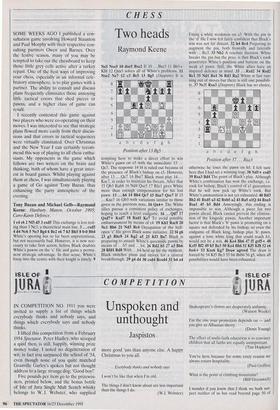CHESS
Two heads
Raymond Keene
SOME WEEKS AGO I published a con- sultation game involving Howard Staunton and Paul Morphy with their respective con- sulting partners Owen and Barnes. Over the festive season, many of you may be tempted to take out the chessboard to keep those little grey cells active after a turkey repast. One of the best ways of improving your chess, especially in an informal cele- bratory atmosphere, is to play games with a partner. The ability to consult and discuss plans frequently eliminates those annoying little tactical errors that shed pieces or pawns, and a higher class of game can result. I recently contested this game against two players who were co-operating on their moves. I was interested to see that strategic plans flowed more easily from their discus- sions and that errors in tactical sequences were virtually eliminated. Over Christmas and the New Year I can certainly recom- mend this way of playing to all chess enthu- siasts. My opponents in the game which follows are two writers on the brain and thinking, both of whom have a great inter- est in hoard games. Whilst playing against them at chess, I was simultaneously playing a game of Go against Tony Buzan, thus enhancing the party atmosphere of the evening.
Tony Buzan and Michael Gelb—Raymond Keene: Hanbuly Manor, October 1995; Cam-Kann Defence. 1 e4 c6 2 N13 d5 3 exd5 This exchange is less test- ing than 3 Nc3, a theoretical main line. 3 ...exd5
4 d4 Nc6 5 Nc3 Bg4 6 Bet e6 7 h3 Bh5 8 0-0 Bb4 unpretentious,
but opening has so far been npretentious, but not necessarily had. However, it is now nec- essary to take firm action, before Black doubles a White's pawns on the 'c' file and gains perma- nent strategic advantage. In that sense, White's foray into the centre with their knight is timely. 9 Ne5Nxe5 10 dxe5 Bxe2 If 10 ... Bxc3 11 Bb5+ Kf8 12 Qxh5 solves all of White's problems. 11 Nxe2 Ne7 12 c3 Bc5 13 Bg5 (Diagram) It is tempting here to make a direct effort to win White's pawn on e5 with the immediate 13 ... Qc7. The response 14 f4 is ruled out because of presence esence of Black's bishop on c5. However, after 13 ...Qc7 14 Bxe7 Black must play 14 ... Kxe7, in order to maintain his threats. After that 15 Qb3 Rabb 16 Nd4 Qxe5 17 Rfel gives White more than enough compensation for his lost pawn. 13 ...h6 14 Bh4 Qc7 15 Bxe7 Qxe7 If 15 Kxe7 16 Qb3 with variations similar to those given in the previous note. 16 Qa4+ The White allies pursue a consistent policy of exchanges, hoping to reach a level endgame. 16 ...Qd7 17 Qxd7+ Kxd7 18 Rad I Ke7 To avoid possible embarrassment by means of c4. 19 Kbl. Rac8 20 Ncl Bb6 21 Nd3 Rc4 Occupation of the half- open 'c' file gives Black some initiative. 22 f4g6 23 g3 RhcS 24 Kg2 a5 25 Kf3 Ba7 Black is preparing to assault White's queenside pawns by means of ... b5 and ...b4. 26 Rd2 b5 27 a3 Bb6 28 Rfdl Rd8 With ...b4 held up for the moment, Black switches plans and strives for a central breakthrough. 29 g4 d4 30 cxd4 Rcxd4 31 b4 a4 Fixing a white weakness on a3. With the pin in the 'd' file I now felt fairly confident that Black's win was not far distant. 32 h4 Rc4 Preparing to augment the pin, both frontally and laterally with ... Rc3. 33 Nb2 A resolute decision. White breaks the pin but the price is that Black's rook penetrates White's position and battens on the weak a3 pawn. Still, the White allies have an inspired defence in mind. 33 ... Rxd2 34 Rxd2 Rcl 35 Ndl Ral 36 Rd3 Rat White is fast run- ning out of moves but there is still one possibili- ty. 37 Nc3! Rxa3 (Diagram) Black has no choice, otherwise he loses the pawn on b5. I felt sure here that I had set a winning trap. 38 Nd5+ exd5 39 Rxa3 Bd4 The point of Black's play. Although White's combination has won the exchange, i.e. rook for bishop, Black's control of al guarantees that he will now pick up White's rook. But White's ammunition is not yet exhausted. 40 Rd3 Bbl 41 RxdS a3 42 RxbS a2 43 Ra5 alQ 44 Rxal Bxal 45 b5 Bd4 Annoyingly, this ending is impossible to win. Although a piece for two pawns ahead, Black cannot prevent the elimina- tion of the kingside pawns. Another important factor is that Black's `11' pawn is promoting on a square not defended by his bishop, so even the endgame of Black king, bishop plus 'h' pawn, against a lone white king that could reach hl, would not be a win. 46 Ke4 Bb6 47 f5 gxf5+ 48 KxfS Bf2 49 h5 Be3 50 Ke4 Bb6 51 Kf5 Kf8 52 e6 fxe6+ 53 Kxe6 Kg7 Draw agreed The draw is forced by 54 Kf5 Be3 55 b6 Bxb6 56 g.5, when all possibilities would have been exhausted.










































































































 Previous page
Previous page